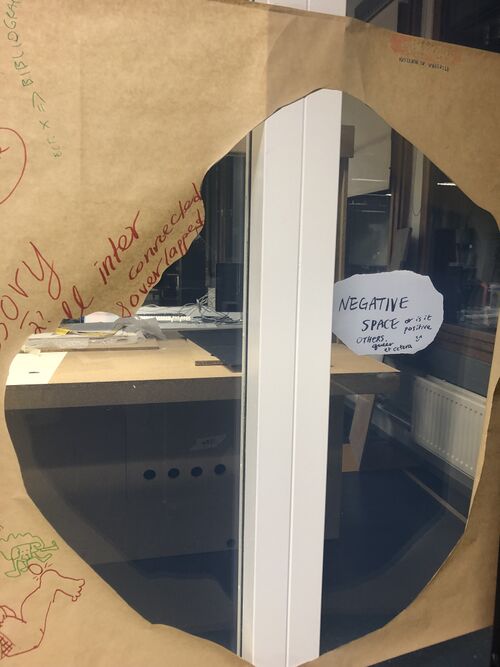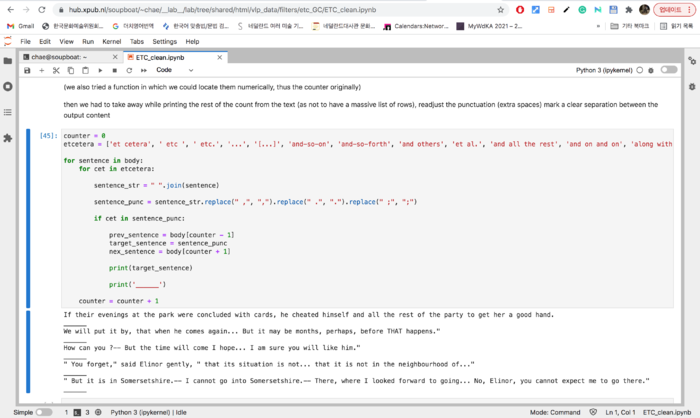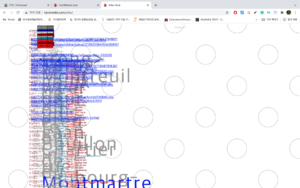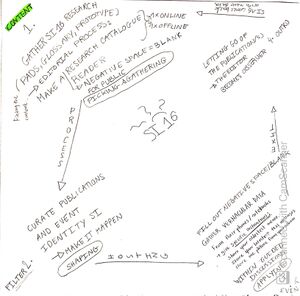Etc Portal to Contamination
etc filter as an entry point to look into rejected space which can be a starting point
An etc filter as an entry point/door to address/look into negative space/rejected space which can be a starting point, yet to be defined.
overview
In the beginning, Gersande's(G) interest in the rejection list was 'rejection as a starting point', and Chae(C)'s was: 'rejection as a turning point-a trigger for an action/a change/a different direction'.
C was stuck with the word, 'et cetera' because:
1) MICHEL FOUCAULT Order of Things (Preface)
2) she was curious to look into what goes under this ambiguous et cetera(and others) boundary.
G's interest started from the work of an AI researcher, Sennay Gebhreab.
As C and G were learning how to analyze/process txt. files and categorize/structurize using NLTK functions for several weeks, C and G thought what if we shine a light on the usage of 'etc.' which is usually neglected in text and dialogues. With an intention to see 'et cetera' as a negative space, C and G invite ppl to negative space where concept/a word/.../ resides, and encourage readers to imagine what concept/a word/.../ is under that space in an attempt to reflect our way of talking, our way of categorizing and our way of writing text.
week 7, 1st of November / Prototyping
During the class, Manetta and Michael introduced us to the concept of corpora and filter. C and G were in a group (cuz we were sitting next to each other(=´∀`)人(´∀`=)) and we started a discussion about our interest in regards to the topic of 'rejection'. G mentioned Sennay Gebhreab(will be filled in) who focuses on the racial bias in A.I. and the relation between colonialism and technology.(maybe not correct.. G, plz feel free to edit) C talked about her fascination with the 'other' category and et cetera.
During the class, Manetta helped C and G to write code that goes through the NLTK corpus('mobydick', 'pride and prejudice', etc.)
etc filter
C and G's intention was:
1) make a et cetera & co filter
2) to give readers a context, not only print/return the target sentence(a sentence that contains etc.) but also print/return previous and next to the target sentence
3) ...(to be continued...)
here are some snippets from G and C's Jupyter notebook.
from nltk.corpus import Gutenberg
gutenberg.fileids()
print(body)
counter = 0
etcetera = ['et cetera', ' etc ', ' etc.', '...', '[...]', 'and-so-on', 'and-so-forth', 'and others', 'et al.', 'and all the rest', 'and on and on', 'along with others']
for sentence in body:
for cet in etcetera:
sentence_str = " ".join(sentence)
sentence_punc = sentence_str.replace(" ,", ",").replace(" .", ".").replace(" ;", ";")
if cet in sentence_punc:
prev_sentence = body[counter - 1]
target_sentence = sentence_punc
nex_sentence = body[counter + 1]
print(prev_sentence, target_sentence, nex_sentence)
print('______')
Our first result was this: ...(to be continued...)
week 8, 8th of November / Prototyping
Before class
before the prototyping class, G and C had a meeting about what they thought about et cetera. This meeting was a brainstorming session for both of us. Here is the list of keywords that C and G talked:
- cut-ups
- filters
- functions(adj)
- etc rebuilder
- Jane Austen flirting tool
- time-saving tool
- incomplete info, infinite list of things
- direction that is continuous (like and...)
- do we see etc. or others categories in a contemporary context?
During class
G and C learned how to make input-etc etherpad and output-etc etherpad using API!! C IS SUPER EXCITED ABOUT THIS METHOD.
week 8, 9th of November / Class with Cristina
After having a check-in moment and group discussion with Cristina from 10:00 - 17:30(!!), G and C agreed on the following things:
1) filter etc & co
→ synonyms
→ gate to the negative space
in notebook/logbook (Jupyter-like layout),
2) Run the filter etc & co
→ use the filter to find negative space in content online(things that we wrote in etherpads, NLTK corpora, references gathered by XPUB1 and Cristina, Steve, Manetta, and Michael)
3) yet-to-be-named-publication
→ physical publication
→ annotations/updates can go back to the notebook
→ logbook as intro
→ the instructions
→ negative space waiting to be filled
4) And others(Mainly documentation)
→ track and tracing nomadic publication
→ C and G delivery service, pick-up
→ hand-to-hand
→ last reader/author chooses the next one
...back to number 1), full circle ⥀
week 8, 13th of November / meeting at C's house
for the proposal to the group meeting on the 16th of Tuesday, C and G had a meeting. Then came to these points(yet these points are still draft):
1) picking and gathering content -
gather SP16 research contents(pads, glossary, protype) → editorial process → make a [research catalogue, reader, negative space = blank] for public in both online and offline format
2) filter(we might use different word)
curate publications and event, identity design of SP16,
3) applying - gather vernacular data
this stage take place at Varia, a) filling out negative pages/blank spaces b) guided discussions
audiences, visitors will be given very specific&clear instructions and XPUB will use their phones to gather vernacular data.
sample instructions might be as such:
- pick and share your oldest memo in your memo app
- pick and share your latest text message
- pick and share one picture from your photo album
- pick and share one of the unclosed web page content
4) outro
letting go of the publication, at this stage the editor becomes the observer




